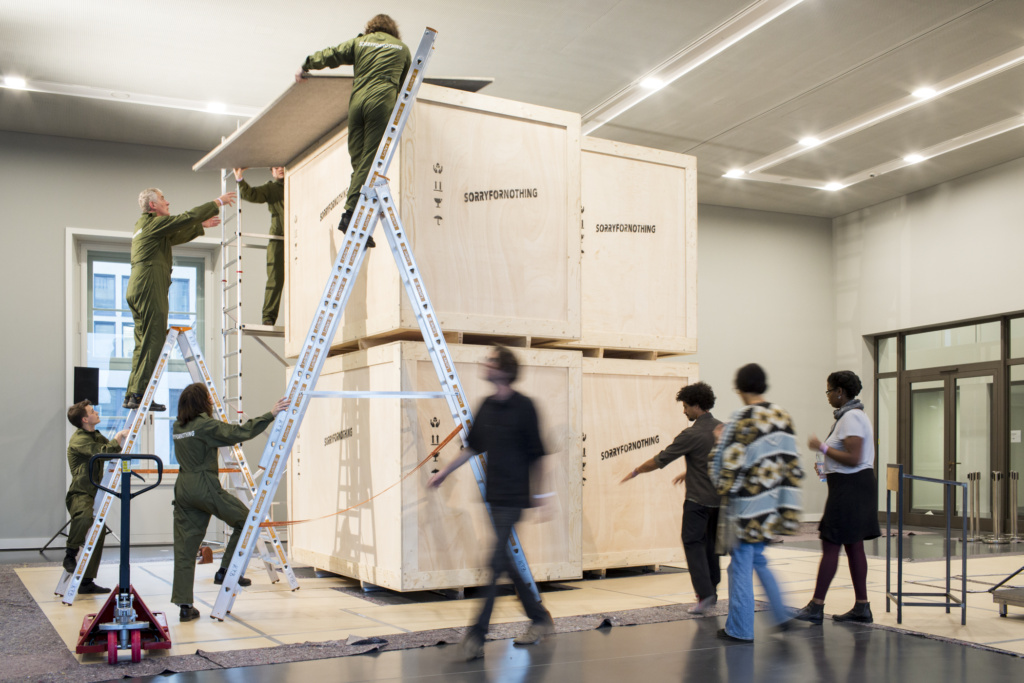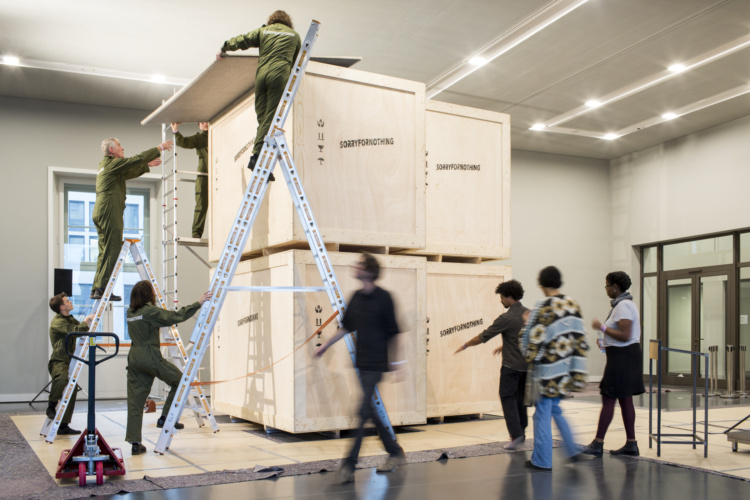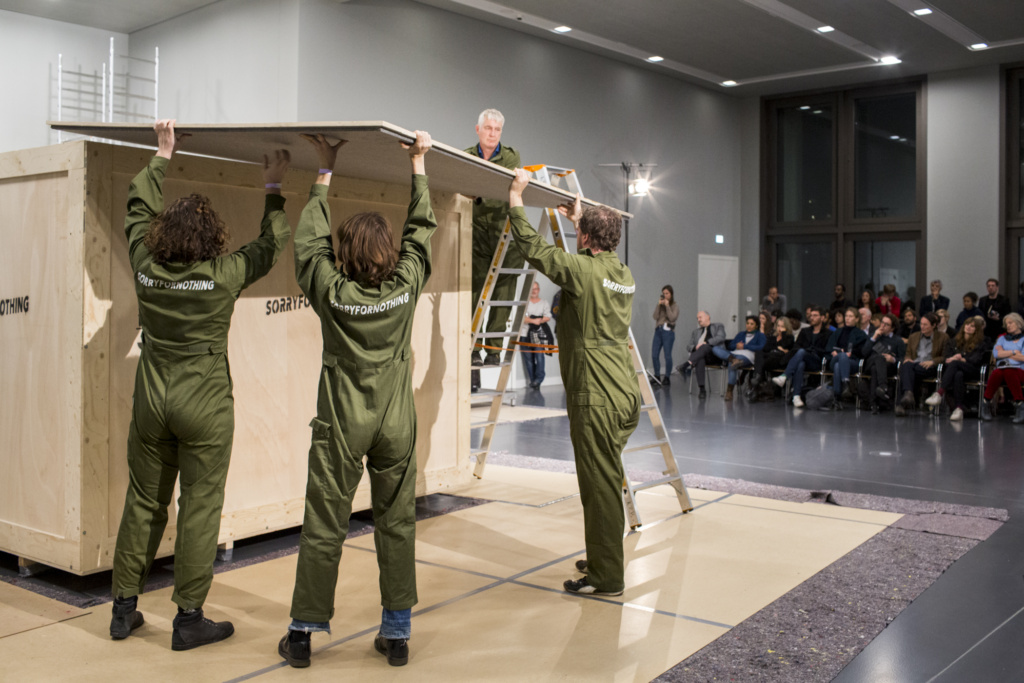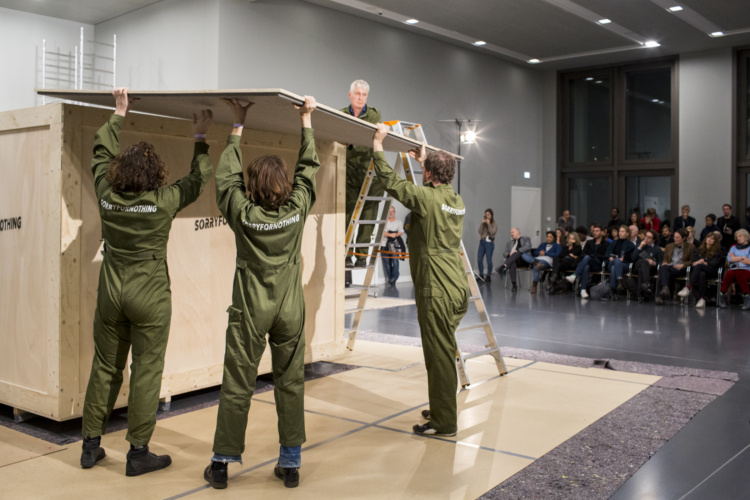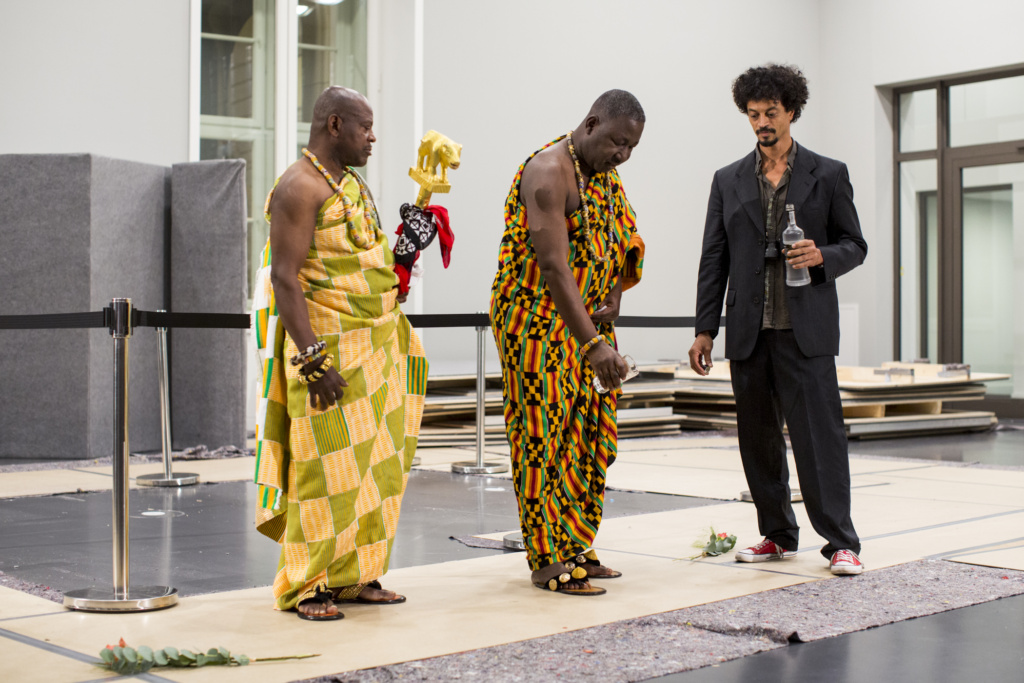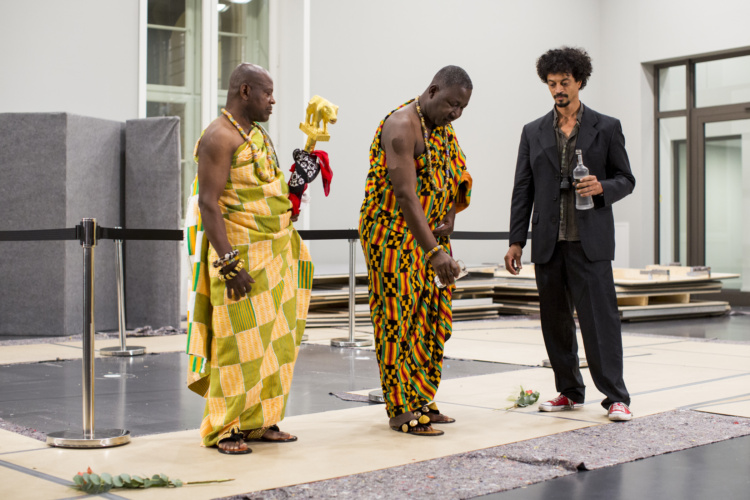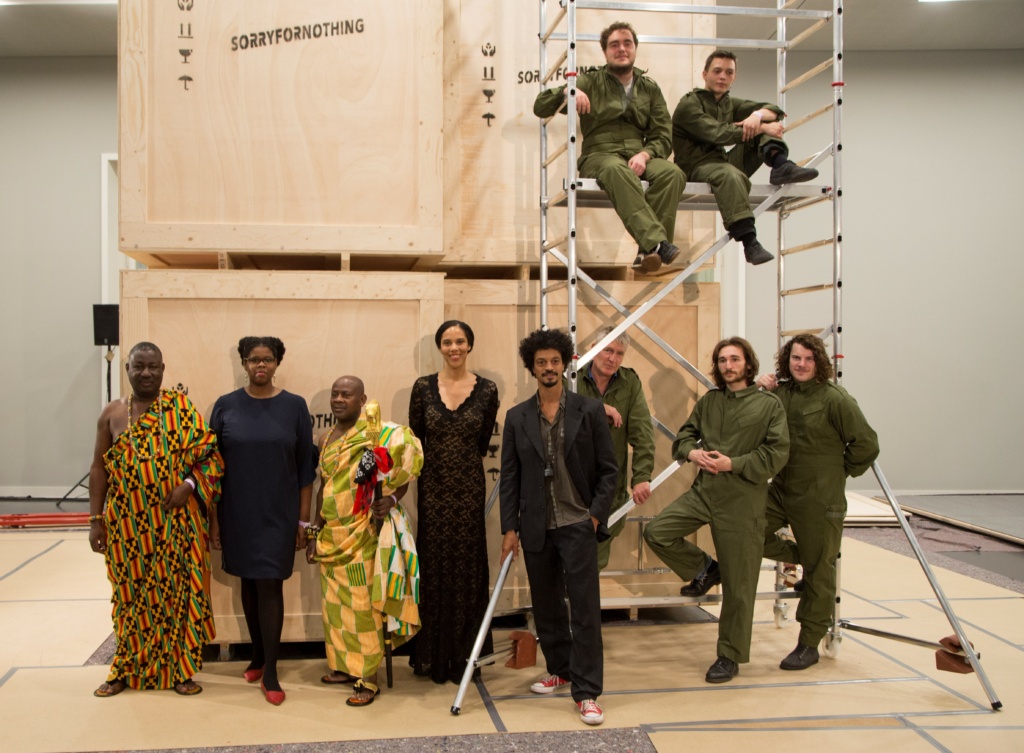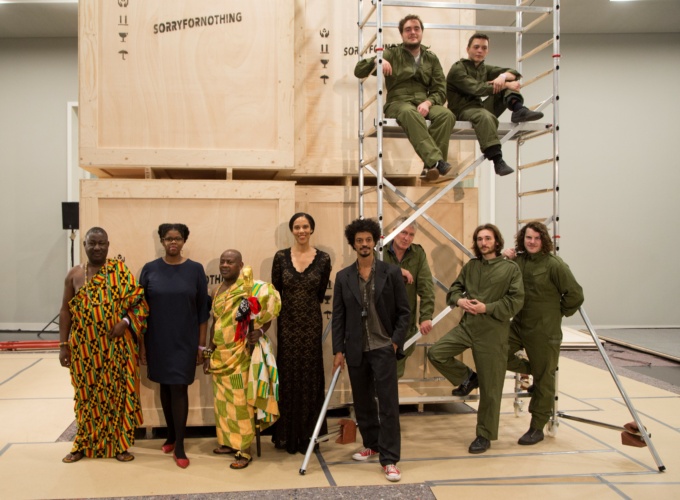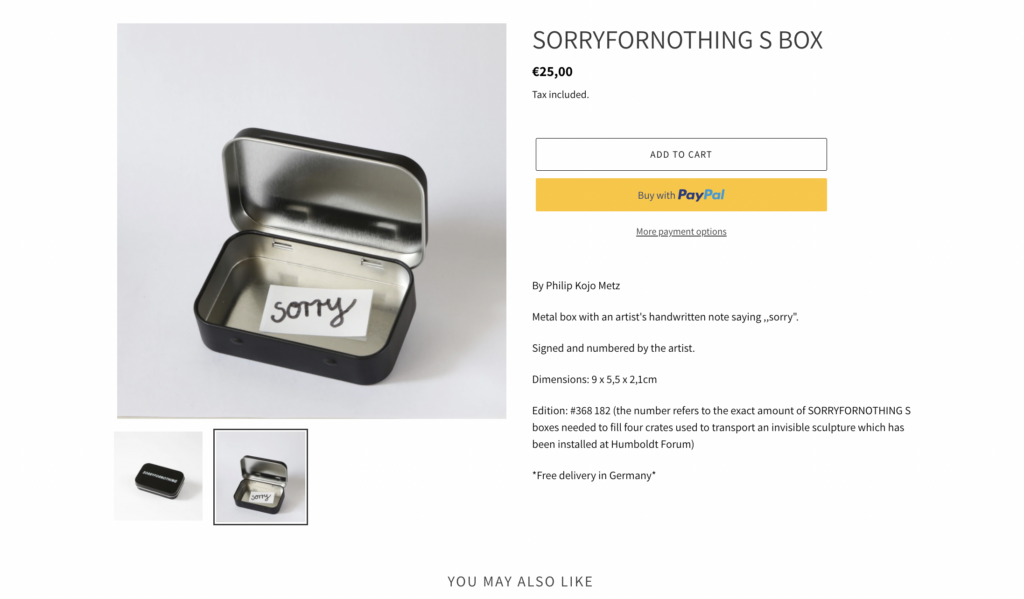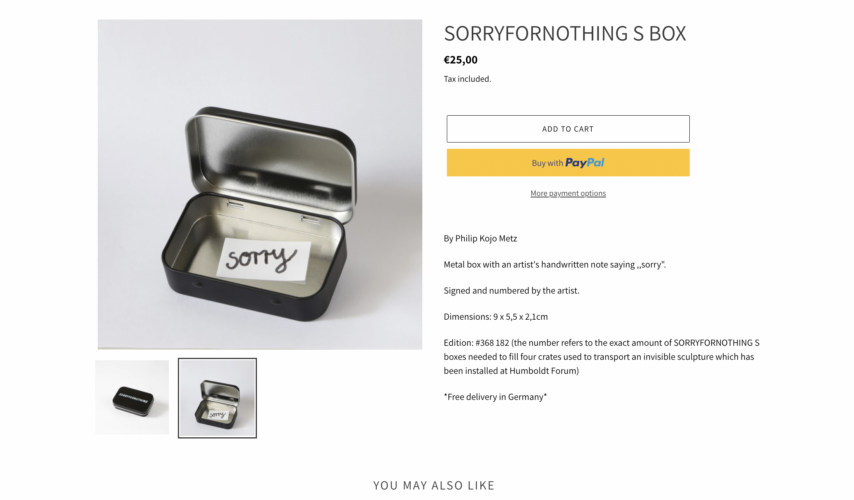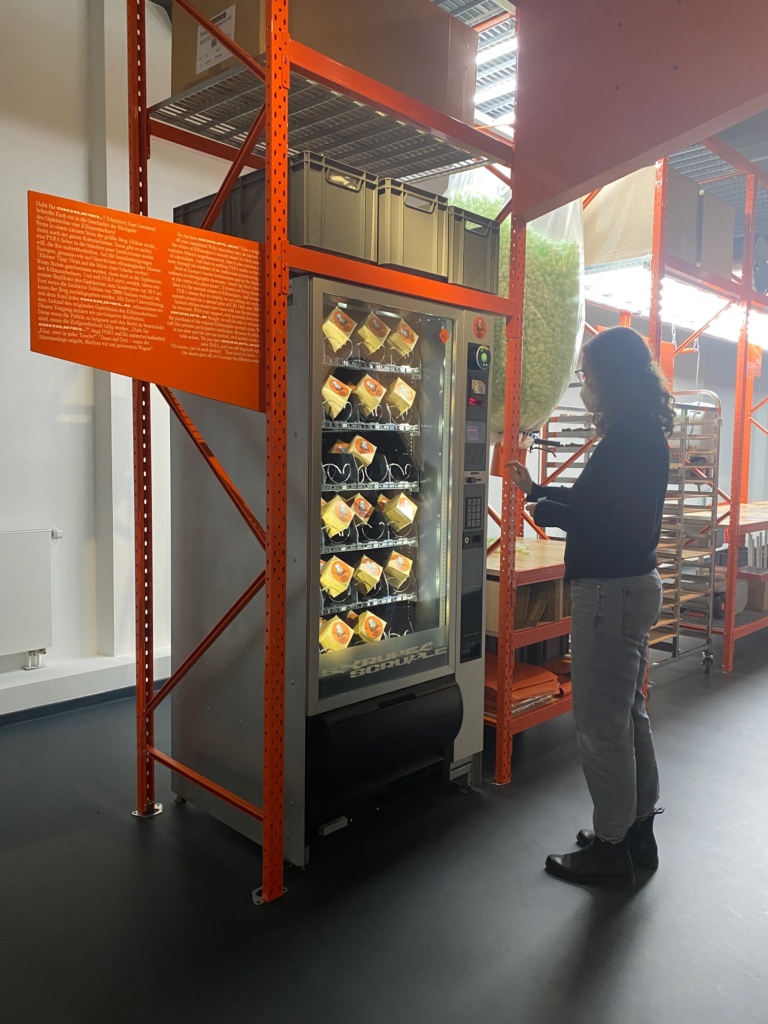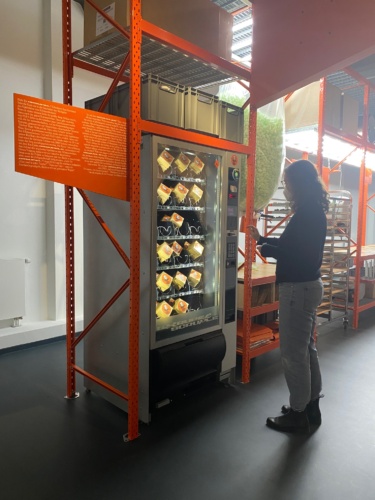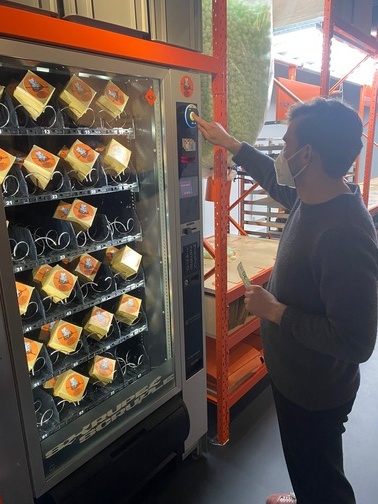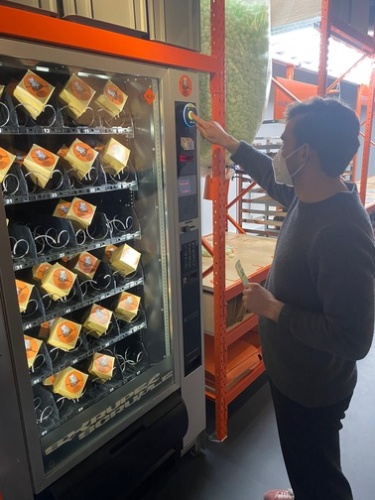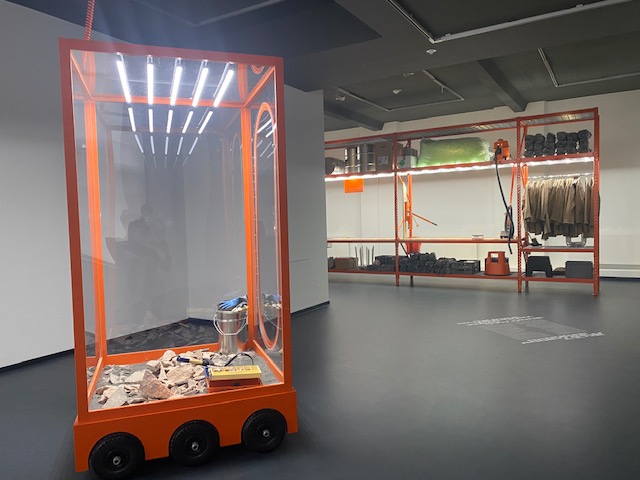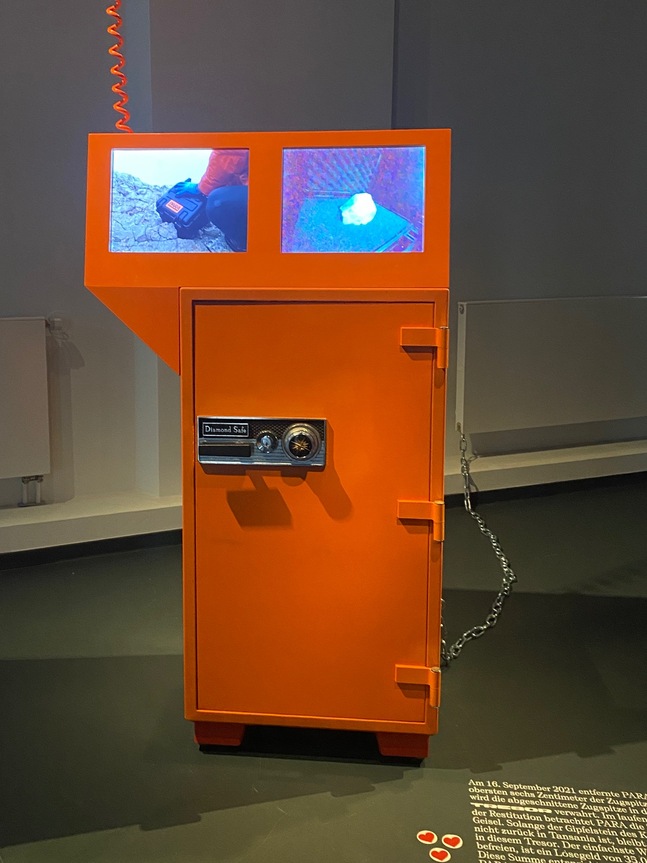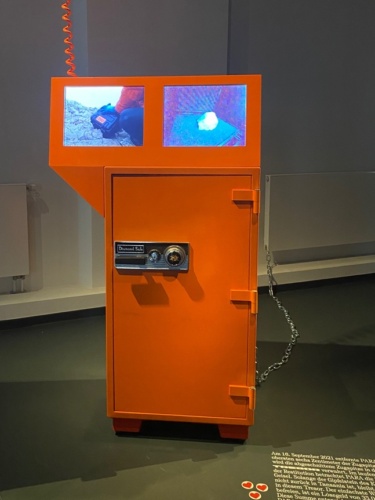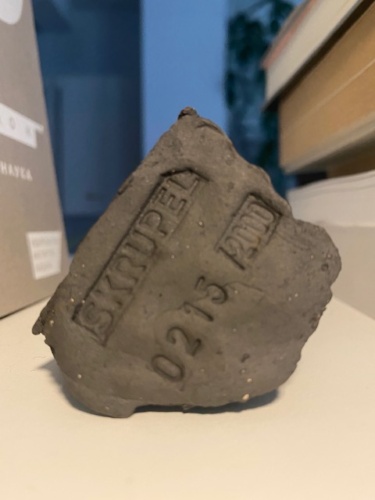Employing the theoretical framework of participatory countermonuments, this essay discusses Philip Kojo Metz’s performance and sculpture SORRYFORNOTHING (2020), which can now be seen in the ‘Berlin Global’ exhibition at the Humboldt Forum, and the ‘Moving Mountains’ (2021–2022) exhibition of the artist collective PARA and artists Rehema Chachage and Valerie Asiimwe Amani, at the GRASSI Museum für Völkerkunde zu Leipzig.
Participatory Countermonuments of Colonial Violence
by Andrei Zavadski and Irene Hilden on April 7, 2022
As Germany’s remembrance culture is visibly moving towards more inclusivity, histories and memories of colonial violence are finally reaching broader publics. Having been subject to academic debates and activist efforts for decades, colonial pasts and postcolonial presents have permeated the mainstream media landscape and, more recently, entered major museums and other cultural institutions. Seeking to confront their own colonial legacies as well as societal postcoloniality in general, museums are rethinking the objects they show and the stories they tell, and change who tells these stories and how. One of the key strategies in this endeavour has been to involve artists. More and more often, exhibition creators turn to art to reflect critically on the museum, its history and heritage, and its entanglement in the existing societal structures. While examples of relevant artistic projects in museum spaces are many and diverse, we would like to discuss what we see as a particular kind of such work, namely performative participatory countermonuments of colonialism.
Countermonuments were first theorised by James Young (1993), in relation to Germany’s remembrance of the Holocaust. He writes of a generation of artists in Germany—Hans Haacke, Norbert Radermacher, and Jochen und Esther Gerz among them—who, in the 1980s, were ‘enacting a critique of memory-places already formulated by cultural and art historians long skeptical of the memorial’s traditional function’ (Young 1993: 28). Discussing the Gerzes’ Gegen-Denkmal (countermonument) to fascism, unveiled in 1986 in Hamburg, Young points to the artists’ intention to create ‘an antifascist monument without resorting to what they regarded as the fascist tendencies in all monuments’ (p. 28). The 12-metre-high column clad in lead that the couple erected in the Harburg district of Hamburg was accompanied by the artists’ invitation for the city’s residents and visitors to inscribe on its surface their names, signatures, and thoughts about the Nazi period, which the Gerzes’ saw as their commitment to remaining ‘vigilant’ (p. 28). When each of the eight one-and-a-half-metre sections was thus covered with visitors’ inscriptions, the column was lowered into the ground, creating space for new graffiti.
Young analyses how the Gerzes’ Gegen-Denkmal disrupts the traditional monument’s modus operandi. It provokes rather than consoles; it constantly changes rather than stays fixed in space and time; it demands interaction rather than grows to be ignored by passers-by; it does not remain pristine, but invites its own ‘violation and desanctification’; and finally, it does not ‘accept graciously the burden of memory,’ but ‘throw[s] it back at the town’s feet’ (Young 1993: 30). In short, the countermonument resists the sacralised monumentality of traditional memorials, opening up space for active remembering.
Importantly, in his analysis of the Gegen-Denkmal, Young also notes the countermonument’s performative and participatory dimensions. The disappearance of the Gerzes’ column depends on how active people are in leaving their writings on it, the end result being that ‘the vanishing monument will have returned the burden of memory to visitors’ (p. 30). While Young does not discuss participation and performance further, they are key to his conceptualisation of countermonuments.
Over the past years, such performative participatory countermonuments have been created by artists working with (post)colonial pasts and presents. Below, we discuss two examples of such works: Philip Kojo Metz’s performance and sculpture SORRYFORNOTHING (2020), which can now be seen in the ‘Berlin Global’ exhibition at the Humboldt Forum, and the ‘Moving Mountains’ (2021–2022) exhibition of the artist collective PARA and artists Rehema Chachage and Valerie Asiimwe Amani, at the GRASSI Museum für Völkerkunde zu Leipzig.
The unveiling of Philip Kojo Metz's SORRYFORNOTHING, the 'Berlin Global' exhibition at the Humboldt Forum. Berlin, October 24, 2019. © Stadtmuseum Berlin und Kulturprojekte Berlin, Foto Louisa M. Summer.
The unveiling of Philip Kojo Metz’s SORRYFORNOTHING, the ‘Berlin Global’ exhibition at the Humboldt Forum. Berlin, October 24, 2019. © Stadtmuseum Berlin und Kulturprojekte Berlin, Foto Louisa M. Summer.
On October 24, 2019, over a hundred people gathered in the space of the future ‘Berlin Global’ exhibition at the Humboldt Forum, which at that time had not yet been fully installed. The audience members waited for what they thought would be the unveiling of a memorial to victims of and resistance to German colonialism. However, the four crates supposedly containing the sculpture turned out to be empty. The artist, Philip Kojo Metz, explained that his sculpture pointed out the gap in Germans’ memory and awareness of colonialism.
The unveiling of Philip Kojo Metz's SORRYFORNOTHING, the 'Berlin Global' exhibition at the Humboldt Forum. Berlin, October 24, 2019. © Stadtmuseum Berlin und Kulturprojekte Berlin, Foto Louisa M. Summer.
The unveiling of Philip Kojo Metz’s SORRYFORNOTHING, the ‘Berlin Global’ exhibition at the Humboldt Forum. Berlin, October 24, 2019. © Stadtmuseum Berlin und Kulturprojekte Berlin, Foto Louisa M. Summer.
The unveiling of Philip Kojo Metz's SORRYFORNOTHING, the 'Berlin Global' exhibition at the Humboldt Forum. Berlin, October 24, 2019. © Stadtmuseum Berlin und Kulturprojekte Berlin, Foto Louisa M. Summer.
The unveiling of Philip Kojo Metz’s SORRYFORNOTHING, the ‘Berlin Global’ exhibition at the Humboldt Forum. Berlin, October 24, 2019. © Stadtmuseum Berlin und Kulturprojekte Berlin, Foto Louisa M. Summer.
The unveiling of Philip Kojo Metz's SORRYFORNOTHING, the 'Berlin Global' exhibition at the Humboldt Forum. Berlin, October 24, 2019. © Stadtmuseum Berlin und Kulturprojekte Berlin, Foto Louisa M. Summer.
The unveiling of Philip Kojo Metz’s SORRYFORNOTHING, the ‘Berlin Global’ exhibition at the Humboldt Forum. Berlin, October 24, 2019. © Stadtmuseum Berlin und Kulturprojekte Berlin, Foto Louisa M. Summer.
Later, the performance acquired a tangible manifestation within the exhibition: a space in its hall dealing with Berlin’s entanglements in (past) global wars was cordoned off, the relevant section of the floor was marked, and pictures from the original unveiling performance were hung on the nearby wall. An additional participatory element of the invisible sculpture has been added later: the KWADRAT gallery representing Metz in Berlin as well as one of the Humboldt Forum’s gift shops are now selling SORRYFORNOTHING L BOX (65€) and SORRYFORNOTHING S BOX (25€), metallic containers of two different sizes, each containing small pieces of paper with the word ‘Sorry’ written on them, as well as SORRYFORNOTHING EYE MASK (25€), all presented as artworks.
A screengrab of Philip Kojo Metz's SORRYFORNOTHING S BOX, KWADRAT Shop. April 7, 2022.
A screengrab of Philip Kojo Metz’s SORRYFORNOTHING S BOX, KWADRAT Shop. April 7, 2022.
Why can Philip Kojo Metz’s work be regarded as a countermonument and what do its performative and participatory dimensions do? As a performance, the unveiling of the invisible sculpture is a powerful gesture. Expecting to see a memorial, the exhibition’s guests encountered emptiness—an absence, a nothing. The artist was not sorry for this nothing—as the guests, representatives of the German public, were implicated in being not sorry for Germany’s colonial violence. This performative act of making its participants aware of their unwillingness to reflect on the (post)colonial past and present, apologise for them, and make amends is a countermonument in itself—fleeting and non-monumental, yet burdensome. The small boxes available for purchase, which come in limited editions, are meant to evoke a similar feeling. Opening such a box, the buyer is confronted with its emptiness and a cynical message ‘Sorry,’ which really says ‘Not sorry.’
However, the exhibit within ‘Berlin Global,’ the performance’s material manifestation, fails to deliver a comparable result. As our ethnographic audience research conducted in the exhibition in July-November 2021 shows, visitors overwhelmingly did not recognise the cordoned-off area as a work of art, as an invisible monument to German colonial violence. Most of our survey participants and interviewees, if they had not had any prior knowledge of what they were experiencing, failed to perceive the sculpture as such. One could say that Philip Kojo Metz thus engages all visitors of ‘Berlin Global’ in a continuous participatory performance, one that highlights their ignorance of German colonialism, refusal to see it––both in the exhibition and overall.
But is this invisible sculpture able to go beyond the status quo? Is it able to transform reality? Failing to create awareness, it diagnoses the problem, but hardly contributes to solving it. Perhaps one of the reasons for this is the placement of the sculpture in a narrow and crowded space of the exhibition, with multiple histories and stories surrounding it. Had it been located in a separate hall, its effect on visitors might have been entirely different. The objects on sale, however, invite the informed (which is essential here) buyer to purchase a reminder of the void in Germany’s remembrance culture, though without knowing where the money will go.
Irene Hilden buying a 'scruple,' GRASSI Museum für Völkerkunde zu Leipzig. Leipzig, March 31, 2022. © Andrei Zavadski
Irene Hilden buying a ‘scruple,’ GRASSI Museum für Völkerkunde zu Leipzig. Leipzig, March 31, 2022. © Andrei Zavadski
On March 3, 2022, after a redisplay under the directorship of Léontine Meijer-van Mensch, the GRASSI Museum für Völkerkunde zu Leipzig, a key ethnological museum in Germany, opened some of its new galleries. Meijer-van Mensch, an experienced museum practitioner and theorist, decided to address the museum’s colonial complicity during and after the formal period of German colonialism, namely the time of the second director Karl Weule, under whose leadership (1907–1926) the museum’s collections had grown enormously.
At the opening, following ceremonial speeches and acknowledgments, the artist collective PARA started to ‘destroy the museum,’ or rather a stone plinth on which a bronze bust of Weule had rested until 2016, in order to use it as a resource for their project of ‘participatory restitution.’ The stone of the plinth, pulverised and mixed with clay, serves to produce 2,000 replicas of the ‘summit stone’ of Mount Kilimanjaro, which was stolen and taken to Germany by Hans Meyer, a former director of the Institute for Colonial Geography at the University of Leipzig. In 1889, Meyer had climbed the Kilimanjaro massif and renamed it Kaiser-Wilhelm-Peak, calling it the highest mountain in the German Empire, given its location in the then German colony that is now Tanzania. Meyer had divided the rock in two, keeping one piece for himself and giving the other to the German emperor, who displayed it in the New Palace in Potsdam. Today, however, the Kaiser’s stone is considered lost: it has been replaced in the Potsdam palace by another stone from Meyer’s mineral collection. The geographer’s half was sold by his inheritors to an Austrian antiquarian.
The installation with the plinth on which a bronze bust of Karl Weule had rested until 2016, and instruments used by PARA for its destruction. GRASSI Museum für Völkerkunde zu Leipzig, March 31, 2022. © Andrei Zavadski
The installation with the plinth on which a bronze bust of Karl Weule had rested until 2016, and instruments used by PARA for its destruction. GRASSI Museum für Völkerkunde zu Leipzig, March 31, 2022. © Andrei Zavadski
As part of the participatory project, the PARA collective invites the public to buy one of their replicas (20€ in the exhibition and 25€ online), intending to use the money raised to repurchase the original stone from the antiquarian and to restitute it back to Tanzania. On a text label next to the assembly line where the replicas are made, the artists address visitors directly:
Do you have scruples [as the artists call the stone replicas]? Take a weight off your conscience! Write yourselves into the history of the return of Kilimanjaro’s summit stone, be part of the participative restitution. If a little stone contains Africa’s largest mountain, then it also contains all of colonialism.
In a kind of reenactment of Meyer’s 1889 expedition, though not involving colonial violence, members of the collective stole a piece of rock from the summit of the Zugspitze, the highest mountain in southern Germany. For the time being, the stone remains locked in a safe, on display at the museum. According to the artists, it has been taken hostage and will be released once the Kilimanjaro stone has been returned to Tanzania.
The assembly line where 'scruples' are produced and the 'vending machine' selling them, part of the exhibition 'Moving Mountains,' GRASSI Museum für Völkerkunde zu Leipzig. Leipzig, March 31, 2022. @ Andrei Zavadski
The assembly line where ‘scruples’ are produced and the ‘vending machine’ selling them, part of the exhibition ‘Moving Mountains,’ GRASSI Museum für Völkerkunde zu Leipzig. Leipzig, March 31, 2022. @ Andrei Zavadski
Andrei Zavadski buying a 'scruple,' GRASSI Museum für Völkerkunde zu Leipzig. Leipzig, March 31, 2022. © Irene Hilden
Andrei Zavadski buying a ‘scruple,’ GRASSI Museum für Völkerkunde zu Leipzig. Leipzig, March 31, 2022. © Irene Hilden
Part of the exhibition 'Moving Mountains,' GRASSI Museum für Völkerkunde zu Leipzig. Leipzig, March 31, 2022. @ Andrei Zavadski
Part of the exhibition ‘Moving Mountains,’ GRASSI Museum für Völkerkunde zu Leipzig. Leipzig, March 31, 2022. @ Andrei Zavadski
A safe containing a piece of rock from the summit of the Zugspitze, part of the exhibition 'Moving Mountains,' GRASSI Museum für Völkerkunde zu Leipzig. Leipzig, March 31, 2022. @ Andrei Zavadski
A safe containing a piece of rock from the summit of the Zugspitze, part of the exhibition ‘Moving Mountains,’ GRASSI Museum für Völkerkunde zu Leipzig. Leipzig, March 31, 2022. @ Andrei Zavadski
With this performative installation, which is part of the exhibition ‘Moving Mountains’ developed in collaboration with the Tanzanian artists Rehema Chachage and Valerie Asiimwe Amani, PARA aims to negotiate the museum’s colonial legacies: its materiality and ‘toxic monumentality’ as well as questions of (dis)possession and extractivism. At the same time, the collective wants to engage the public in a discussion about how to deal with the remnants of colonial histories, in which the museum’s ‘ethnographic’ collections play only one part.
We understand the project as a countermonument because it uses the museum’s ‘debris’ to establish what Dan Hicks (2022) calles ‘new forms of collaborative monumentality.’ The work thus not only calls into question whom and how we remember, but could also set the ground for rethinking the ethnographic museum as a postcolonial institution.
The countermonument’s participatory part works on several levels. Occupying several halls of the museum—halls traditionally filled with numerous ‘ethnographic’ objects (for now, parts of the 2005–2009 permanent exhibition remain on display, highlighting the process of the museum’s ‘reinvention’)—it is hard to pass by without being surprised or unsettled (although audience research in the exhibition remains to be conducted). The guests of the opening ceremony, who witnessed PARA’s destruction of the plinth, were thus also complicit in the ethnographic museum’s self-destruction. This provoked a whole range of reactions, including outrage. Last but not least, an individual visitor purchasing a stone replica confronts the colonial violence and its ripples in today’s society, and, even more importantly, contributes to making things right, both symbolically and literally.
There is another, arguably more problematic, participatory side to this countermonument. On the one hand, the collective sells replicas of the ‘summit stone’ to use the proceeds for the purchase of the original one and its subsequent return to Tanzania. At the same time, visitors to the collective’s website are invited to take part in a discussion of what should happen to the stone and the money collected to buy it, since some people ‘are critical of the purchase because a stone is just a stone.’ While providing an additional participatory level to the performative countermonument, this also potentially compromises the whole artwork by emphasising its symbolism and undermining its literalism. The selling of replicas thus becomes more a comment on participatory restitution and its potential, than a separate act of such restitution.
A 'scruple' bought by Andrei Zavadski, with the number 0215/2000. © Andrei Zavadski
A ‘scruple’ bought by Andrei Zavadski, with the number 0215/2000. © Andrei Zavadski
What unites the two artistic endeavours discussed in this essay is their participatory and performative approach. Efforts to bring colonial violence into the public eye and to prompt people to participate in reflecting on it are giving rise to what we have described here as participatory countermonuments. In addition to the performative dimension of the two installations, there is also a material one. Both the SORRYFORNOTHING boxes and the ‘scruples’ allow the public to acquire a tangible—perhaps even countermonumental—reminder of the gap in the German memory culture and the lack of action directed at dealing with the pasts and presents of colonial violence. The fact that it is the institution of the museum that invited the two projects, not least to address its own colonial entanglements, gives hope that the decades of efforts towards postcolonial justice by scholars, activists, artists, and curators are finally—if slowly—beginning to pay off.
Young, James (1993) The Texture of Memory. Holocaust Memorials and Meaning. New Haven, Yale University Press.
Dr. Andrei Zavadski and Irene Hilden are postdoctoral researchers in the sub-project Realizations and Reception in the Humboldt Forum, part of CARMAH’s major project Making Differences: Transforming Museums and Heritage in the 21st Century.
